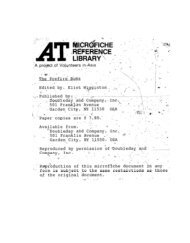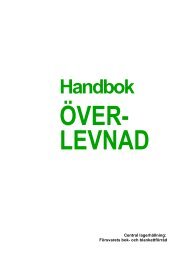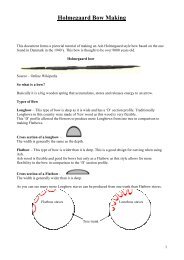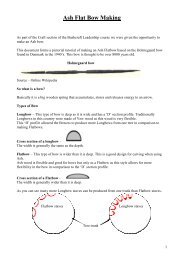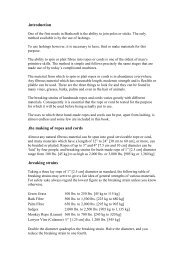Experiments on Knife Sharpening John D. Verhoeven ... - BushcraftUK
Experiments on Knife Sharpening John D. Verhoeven ... - BushcraftUK
Experiments on Knife Sharpening John D. Verhoeven ... - BushcraftUK
You also want an ePaper? Increase the reach of your titles
YUMPU automatically turns print PDFs into web optimized ePapers that Google loves.
[9] Summary and C<strong>on</strong>clusi<strong>on</strong>sThese experiments have been directed at evaluating the edge quality of thesharpening process with regard to the following properties: 1) Edge width at the tip ofthe edge, 2) Edge straightness and edge roughness as viewed from the face of the blade,and 3) Face smoothness. All of these properties were evaluated from SEM micrographstaken <strong>on</strong> edge and face views of sharpened blades.The bulk of the experiments were carried out <strong>on</strong> AEB-L stainless steel bladeshaving a hardness of HRC = 60. A small number of comparative experiments were d<strong>on</strong>e<strong>on</strong> three n<strong>on</strong> stainless steels, 1086, 52100 and a genuine Damascus steel, at hardnesses ofboth HRC = 60 and 40.The majority of the blades were sharpened with either the Tru H<strong>on</strong>e sharpeningmachine, see Appendix 3 or the Tormek sharpening machine, see Appendix 2. A limitednumber of blades were sharpened <strong>on</strong> flat st<strong>on</strong>es with a holder jig to maintain a c<strong>on</strong>stantsharpening angle.Two angles were defined to characterized the sharpened edge. Figure 4 shows thetwo angles: the edge angle, 2β and the face angle, 2α. These angles were measured withboth a laser goiniometer described in Appendix 1, or by metallographic secti<strong>on</strong>ingfollowed by measurements <strong>on</strong> an optical microscope, see Fig. 41 and Fig. A13.Coarse sharpening was d<strong>on</strong>e with both ceramic st<strong>on</strong>es or wheels of 220, 600 and1000 grit, with a diam<strong>on</strong>d h<strong>on</strong>e of 1200 grit, with a fine aluminum oxide st<strong>on</strong>e, and withJapanese waterst<strong>on</strong>es of 6000 and 8000 grit or a waterst<strong>on</strong>e wheel of 4000 grit.Final h<strong>on</strong>ing was d<strong>on</strong>e by three different methods:(1) Steeling with smooth steels.(2) Polishing <strong>on</strong> leather, either clean or loaded with sub-micr<strong>on</strong> size chromium oxidecompound or diam<strong>on</strong>d compound. The leather polishing was d<strong>on</strong>e both by stropping<strong>on</strong> flat leather or by use of a leather wheel <strong>on</strong> the Tormek machine. In all cases theedge angle of the polish was carefully c<strong>on</strong>trolled to values slightly larger than the asgroundedge angle by an amount called ∆β.(3) Buffing d<strong>on</strong>e <strong>on</strong> felt and/or cloth wheels loaded with aluminum oxide compound.Major C<strong>on</strong>clusi<strong>on</strong><strong>Knife</strong> sharpening experts [1,2] teach that for a knife with a given face angle, 2α,the edge angle, 2β, should be formed <strong>on</strong> st<strong>on</strong>e or belt media by maintaining a fixed grindangle and gauging when the edge face is ground out to the edge by detecti<strong>on</strong> of a bural<strong>on</strong>g the edge. This study addresses the questi<strong>on</strong> of which final polishing (h<strong>on</strong>ing)technique is best to remove the bur and smooth the edge face. The major c<strong>on</strong>clusi<strong>on</strong> ofthe study is that of the three h<strong>on</strong>ing methods studied, the best method for removing thebur and setting the edge angle is clearly a final polish <strong>on</strong> leather loaded with a polishingcompound such as the chromium oxide or diam<strong>on</strong>d compounds used here. Edge quality43



